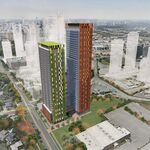I've come to the view (not that my view comes from any particular expertise in the area) that the Gardiner should come down at Spadina. Looking at all the Southcore development, it is a real shame that this area is hampered by an elevated expressway that rips through it. While the rail corridor is as big or bigger a barrier between the city proper and the waterfront, it is the Gardiner that cuts through a developing neighbourhood. This might be justified if the Gardiner east of Spadina was a key component of getting rush hour traffic in and out of the City, but I really don't think it is.
As someone who overlooks the Gardiner from my office (but who admittedly has no training in traffic studies), my observation (consistent with what some others have said in this thread) is that the main use of the elevated expressway east of Spadina is not to assist peak traffic into and out of the city at rush hour, but instead to permit the relatively unimpeded flow of through traffic at rush hour. If anything, the raised Gardiner serves as an impediment to people getting into and out of the City due to the limited access ramps.
Main rush hour traffic into the City gets off at Spadina, York, Bay and Yonge. The current plan as I understand it is to have all traffic come down at Spadina and Simcoe. The Spadina ramp with forced left turn is a mess. I was recently backed up here at 9:30 a.m. on a Saturday. I would be concerned about congestion on the Simcoe ramp if that is the sole exit for York, Bay and Yonge. But more than that, it makes clear that the sole purpose of the Gardiner east of Simcoe will be to serve through traffic or the Jarvis exit. This is a small amount of traffic, and does not justify an elevated expressway through what is soon to be a core part of the city. The Lakeshore/Gardiner east of Jarvis is essentially a double decker expressway serving traffic that could easily manage on 3 lanes each way with stoplights at Jarvis, Sherbourne, Parliament and Cherry.
Much better to have everyone come down at Spadina with a major avenue thereafter and properly managed lights and turns without the complications caused by ramps, such as the difficulty getting into a left hand turn lane for Yonge (as an example).
The amount of traffic being sent into Southcore would have been much improved with the Front Street Extension, but even without that I think there is a definite possibility that getting rid of the Gardiner east of Spadina will help car commuters in the core.






